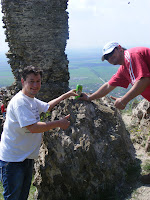



May 2: Day of Youth
A good lesson in Romanian planning. On this day we organized several competitions for the local youth: Chess, Remy and Backgammon in the youth center, and football near the edge of the village. During the day, hardly anyone showed up in the center. Only when we had lost all hope –and the football tournament had ended, the kids entered the center to play games. Not according to any scheme, but just to have fun.
The closure of the day was a concert in the local cultural house. Due to an accident it started one-and-a-half hours later, but surprisingly this didn’t affect the amount of spectators. In between the Romanian popular music and a supposedly humoristic act making fun of all the gypsy clichés (the ones present in the room were the ones laughing the most) there was a small award ceremony. For the first time I noticed a rivalry between the Romanian and the Roma kids. Every participant received a diploma and a t-shirt. Everything in orange – you may draw your own conclusions.



May 5: Men’s day
The 8th of march is international women’s day. According to a survey most Romanians believe they don’t have enough holidays. That’s why one of the biggest beer brands here started a campaign to make the 5th of may national men’s day. What started as pure marketing now becomes more and more serious. To be honest: I didn’t do anything special this day.
May 9: Day of
Most of the children here have relatives working abroad. And yet,
On the day itself we were invited at the local kindergarten to attend their special event. Not all the flags were drawn correctly, but it’s the thought that counts. Their songs, poems and dances were adorable.
In the youth center we organized a quiz, following the ‘Ren-je-rot’ (who knows the international name?!) formula. After our experience of one week earlier, we feared that no one would show up, but in the end fifteen kids participated in the activities. Especially the goodies (propaganda?) provided through the information office of the European Parliament proved to be a great success. We closed the day with another infamous Villa party in




May 10: Nunta (wedding)
This was as well the Day of Ecological Action in
In the evening I experienced my probably biggest cultural shock so far. The son of one the George’s was going to marry and Ruth, Egija and me were invited for the party. After spending a day in very international company we ended up in a very local happening. Three hundred guests were sitting at long tables in the cultural house (see also Second day of Easter and Day of Youth). Arriving at 10, we were just in time for the first course of a meal which would last until 3 am, when the wedding cake arrived. In between the courses there were drinks, more drinks, familiar and new faces, and – despite the lack of space – a lot of dancing. On popular Romanian music of course. After half past three we were allowed to leave, but not without experiencing the situation of giving a, for Romanian standards, very modest wedding present to a pair we didn’t know at all. Still, we received our souvenir: a box of cookies and a can of beer. Timisoreana.



May 17: Disco in Şiria
A full week without any special occasions or parties. We had to celebrate this. The kind kindergarten teacher took us to the local disco in her town. It sounds much worse than it actually was. One can actually get used to manele when they play other music as well. The way people dress and behave was simply amusing. (Or is it just me getting old?) Beer was still cheap. Plenty of space outside. There was only one odd thing. Orange posters all over the place and every hour the orange party song. As I wrote before – sometimes it’s difficult to keep things separate here.















